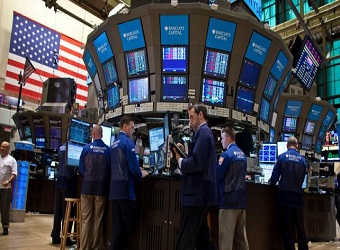The Dow Jones industrial average fell sharply on Tuesday, pressured by a steep decline in Walmart shares and a rise in interest rates.
The 30-stock index closed 254.63 points lower at 24,964.75, snapping a six-day winning streak, with shares of Walmart shedding 10.2 percent. The retail giant’s stock posted its biggest decline since January 1988.
The S&P 500 pulled back 0.6 percent to 2,716.26, with consumer staples declining more than 2 percent. The broad index also closed lower for the first time in seven sessions. Walmart was the biggest decliner in the S&P 500. Kroger and Kraft Heinz, which are also in the staples sector, were among the worst-performing stocks in the index.
The Dow and S&P 500 broke below their 50-day moving averages, two key technical levels. The Nasdaq composite fell 0.1 percent to 7,234.31 as a rally in tech stocks evaporated in afternoon trading.
“We’re running into some technical resistance here,” said Daniel Deming, managing director at KKM Financial. “We’re also coming off a nice bounce-back” from the lows seen earlier this month,” Deming said.
Deming also noted that front-month Cboe Volatility index (VIX) futures were trading higher than the rest of the curve, signalling “we’re going to need some more repair work.” The VIX rose 6.4 percent to 20.71.
A rise in interest rates toward multiyear highs also pressured stocks.
The benchmark 10-year U.S. note yield rose to 2.886 percent, after hitting its highest level since 2014 last week. The short-term two-year note yield, meanwhile, traded around a nine-year high.
Higher rates have kept Wall Street on edge recently as investors fear higher inflation could lead the Federal Reserve to tighten monetary policy faster than expected.
“In the medium-to-long term, higher interest rates will be a concern for the market,” said Zhiwei Ren, managing director and portfolio manager with Penn Mutual Asset Management. “But I don’t think that’s going to kill this bull market.” He noted the benefits from fiscal stimulus will ultimately outweigh higher rates and the bull market would continue.
The S&P 500 suffered a 10.2 percent pullback between Jan. 26 and Feb. 8, losing $2.5 trillion in value, according to Howard Silverblatt, senior index analyst at S&P Dow Jones Indices. As of Friday’s close, the broad index had regained $1.3 trillion, Silverblatt said in a note.
“The equity markets snapped back from a deeply oversold condition last week,” Bruce Bittles, chief investment strategist at Baird, said in a note to clients. “At this juncture, the 10% decline from the January high is seen as a normal correction in an ongoing secular bull market.”
“Although the economic fundamentals suggest the correction has run its course, the technical indicators leave open the potential for a retest of the recent lows,” Bittles said. “Excessive investor optimism that was pervasive in January has been replaced with caution and skepticism but there is a lack of evidence that fear has entered the building, which is often found at a good market low.”
U.S. markets reopened Tuesday after a long holiday weekend. In the previous session, the S&P 500 ended its best week since 2013. But stocks closed off their highs Friday, as developments in the U.S. political space unfolded.
On Friday, the office of U.S. Special Counsel Robert Mueller indicted 13 Russian nations and three entities from Russia for alleged illegal interference in the 2016 presidential election.
The defendants allegedly conducted “information warfare” against the U.S. to “sow discord” into its political system through the use of fictitious personas and online platforms such as social media. The Kremlin has since said here was no significant evidence of meddling from Russia in the 2016 presidential election but provided no further information.
Source: CNBC
